From Iceland – Gunnar Ármannsson: And the Adventure Continues
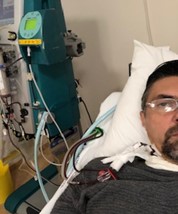 The Big Repair Year 2019.
The Big Repair Year 2019.
I anticipated receiving chemotherapy later in the year, but that didn’t stop me from setting an ambitious running schedule–highlighted by a marathon in Antarctica. The Antarctica marathon in March would complete my goal of running marathons in all seven continents. My running regime started slowly that year as I recovered from my second hand surgery, not to mention my symptoms from Dupytren’s Disease. After a few quiet weeks, I increased my training volume. My endurance improved little by little despite my decreasing hemoglobin, which goes to show that exercise is beneficial no matter your physical condition. But as the Antarctica marathon drew closer, the paraprotein, IgM, steadily increased, so much so that my doctor said I could not go to Antarctica unless I underwent extracorporeal hemodialysis. Plus, my numbers would have to be good. It was a close call, but I received the doctor’s permission to travel to Antarctica–the day before departure!
The journey from Iceland to Antarctica, with a layover in Argentina, went well. And on March 24, 2019, I finished the marathon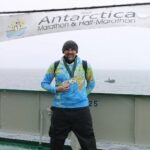 with my wife and two good friends. My friend and I were the first Icelanders to finish running a marathon in all seven continents. Our wives had run marathons on six continents, with only Africa remaining. It was an unforgettable trip and worth having the hemodialysis, though I have no interest in undergoing that treatment again.
with my wife and two good friends. My friend and I were the first Icelanders to finish running a marathon in all seven continents. Our wives had run marathons on six continents, with only Africa remaining. It was an unforgettable trip and worth having the hemodialysis, though I have no interest in undergoing that treatment again.
Next on the agenda was a marathon in Madagascar in June, which would be after the start of my chemotherapy treatments. I had hoped to avoid chemotherapy until the fall, but my blood values changed those plans. But before chemo, I opted to receive a laparoscopic cardiomyotomy due to swallowing problems from achalasia. The ailment had bothered me for several years and was getting worse. By spring, I could hardly finish a meal.
The operation went well, and I received my first of six chemo treatments in the middle of May. I was given Rituximab and Bendamustine. I tolerated the medication well and even participated in a 10 km run the day after an infusion. However, it quickly became clear that I couldn’t run until a week after an infusion.
In early June, we again embarked on a long journey, this time to Madagascar in Africa. On June 19, 2019, the four of us finished the marathon, and our wives joined the club of Icelanders who have completed marathons on every continent.
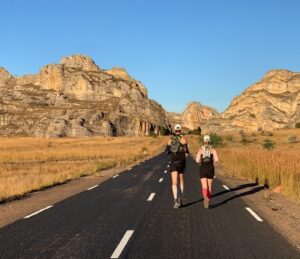 This marathon turned out to be my most difficult yet. I and others contracted severe diarrhea the day before the race and didn’t sleep that night. We got medicine from a doctor to stop the diarrhea temporarily so that we could try to run. But the situation was not good–no carbohydrate intake, no minerals and little nutrition. The weather forecast in the morning was bright sunshine and calm wind. But the mantra for us marathoners is: “I am a marathoner, I must run.” After running a grueling 27 km, I decided to walk the remainder of the race. We had 7 hours to finish the race and four hours had already passed when I started walking. Worrisomely, I almost passed out after bending down to tie my shoes. Yet I recovered, and we finished the race in just under 7 hours.
This marathon turned out to be my most difficult yet. I and others contracted severe diarrhea the day before the race and didn’t sleep that night. We got medicine from a doctor to stop the diarrhea temporarily so that we could try to run. But the situation was not good–no carbohydrate intake, no minerals and little nutrition. The weather forecast in the morning was bright sunshine and calm wind. But the mantra for us marathoners is: “I am a marathoner, I must run.” After running a grueling 27 km, I decided to walk the remainder of the race. We had 7 hours to finish the race and four hours had already passed when I started walking. Worrisomely, I almost passed out after bending down to tie my shoes. Yet I recovered, and we finished the race in just under 7 hours.
With this race, I proved that it is possible to run a marathon, albeit slowly, after chemotherapy. Of course, the diarrhea didn’t help my time, either.
I continued to train as much as I could and, after three or four infusions, I decided to sign up for another marathon before my last infusion. If I could run a marathon after one infusion, I could do it after five! So on October 26, 2019, I laced up my running shoes once again and took part in the autumn marathon in Iceland. I finished treatment in November, and traveled to Norway the next month for, you guessed it, another marathon. I finished my fourth marathon of the year in Bergen, Norway on December 7, 2019.
My experiment was over: It is possible to run through chemotherapy. In 2019, I ran 2019 km.
The Covid year 2020.
Strange year. Post-treatment with Rituximab. Fortunately, I didn’t catch Covid and even ran a virtual marathon with my dad and son-in-law. My dad, a 71-year-old cancer survivor with heart arrhythmia, had completed five marathons by 2020–all after he turned 67.
In 2020, I ran 2020 km.
The year 2021, another weird year.
Post-treatment with Rituximab. Repeated illnesses during the year, but no Covid.
I ran three marathons and one ultra marathon. My dad also finished his sixth marathon that year.
Toward the end of the year, I made a medical change to boost my immune system. Rather than going to the hospital every four weeks and receiving IV injections, I began giving myself immunosuppressants under the skin on a weekly basis. That way, I get more of the drug and the injections are more evenly distributed. I had hoped to stop getting sick every other day, but I had to wait at least a year to notice a difference.
In 2021, I ran 2600 km–the same distance I ran in 2018, when the disease progressed again.
The year 2022, my covid year.
Finished the post-treatment in March. I also got Covid three times.
It took me four weeks to recover from my first bout of Covid in February. My running came to a halt, but I recovered and ran a marathon in April and another in May. At the beginning of August, Covid got me the second time, and I ended up being taken by ambulance to the hospital. I was put on steroids for a few weeks. 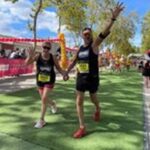
I was registered for the red wine marathon in Medoc, France, at the beginning of September. However, my doctor advised against the race because not much time had passed since my second bout with Covid. So I got a second opinion from a friend who is a physiotherapist. My friend was convinced that the marathon would be good for me. I followed his advice and, alas, my friends and I had a great time.
At the end of October, I took part in an autumn marathon in Iceland. I had finished about 35 km when my heart fell out of rhythm. I managed to finish the race, but I remained out of rhythm until the end of November. I received electrical cardioversion and was able to resume training.
I got Covid for the third time a week before Christmas. Fortunately, my symptoms were mild and I was feeling quite well by Christmas.
The year 2022 was difficult in many respects. And I ran only 1670 km, which is the lowest number since 2012, when I was out of sync for most of the year.
The year 2023. No Covid, little trouble.
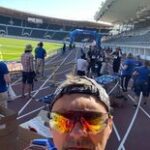 With a Covid reprieve, I finally started to see results from the new immunosuppressant. I had few sicknesses during the year and was able to train quite well.
With a Covid reprieve, I finally started to see results from the new immunosuppressant. I had few sicknesses during the year and was able to train quite well.
I ran 6 marathons and one ultra marathon. I finished one of the marathons in Helsinki, which meant I have run marathons in every capital of Nordic countries.
I collect diseases, the most recent of which is sleep apnea. For the last 30 years, I have been involved in research on lungs, etc.. Nothing significant has ever come up in these once-a-decade investigations. Earlier this year, however, I was diagnosed with sleep apnea. My new bedmate, a sleep apnea machine, seems to be working, as I am not as tired during the day.

Modeling for the Icelandic Cancer society to raise awareness.
I have run 56 marathons in 20 countries, 12 capital cities and 7 continents. In addition, I have run 7 ultra marathons. And this is all after I was diagnosed with Waldenström’s in 2005.
In 2023, I ran over 2600 km. The total km I’ve run since my Waldenström’s diagnosis is almost 43,400 km. For comparison, the circle around the globe is 40,075 km around the equator.
The last 5 years have been both interesting and fun. New challenges and more races. The goals are to run more marathons and visit more countries to run in. And collect years.
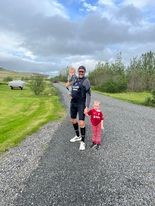 I run because I can – and when I can.
I run because I can – and when I can.
Gunnar Ármannsson
Gardabaer, Iceland
February 2024
Gunnar’s Original Story of Hope From Iceland – Gunnar Ármannsson: “Diagnosed at age 38, running became my lifeline”
Being diagnosed with an incurable cancer is an experience that no one wants to have. But, it certainly gets the attention of those so diagnosed. One asks: what does it mean? What next? What can be done? How much time do I have left? Many such questions go through one´s mind. But in the end, we realize this is simply a part of being a person. Much happens to each of us during a lifetime. All these events add up to make each of us the unique individual our families, friends and colleagues come to know.
I began by thinking, why me? I think that is a normal reaction. But fortunately, I quickly managed to change that thought to, why should it not have been me? After diagnosis, this affliction became simply a part of who I am, and it didn’t change anything to think, what if I had not been diagnosed? That consideration didn’t occur to me, and that is not what my story is about. What is my story is how I, a person diagnosed with WM at a young age, embraced my fate, learned to live with the disease, and moved forward with faith, resilience, and the support of many, through fourteen (and still counting) dramatic but satisfying years.
For those recently diagnosed with WM, in the end my story is just one of many good stories – one more story that tells us that we have a future, even a long future with impacts on our lives that we can turn to good ends, or at the least for which we can develop good work-arounds. I am grateful for the fourteen productive years that good medicine and a good attitude have brought my way, and wish to encourage other WM’ers to be optimistic and to strive for similar outcomes.
Who I was at diagnosis
My first awareness of having the disease was in 2004. During that summer, I started to run occasionally, and I began to notice some changes as the year went by. In the fall of 2004, I noticed that it was more difficult to run uphill. By winter, I found my endurance was diminishing and began noticing greater fatigue when playing indoor soccer in my regular weekly game. By the fall of 2005, I found myself requiring short mid-game rests when I played soccer or when I did other vigorous exercise. On December 22, 2005, I went to the gym, as I had done all autumn, to try to improve strength and endurance. After training, I went to a hot tub and sat there for a while. As I was getting out of the tub, I almost passed out, and I just managed to grab the railing so I didn’t fall. Only then did I realize that my condition was not normal and that I had better be examined. You may wonder why it took me so long to realize that there was something wrong with me. Quite simply, I was in my prime, and as I always had been active and had never experienced any major illness. It simply never occurred to me that there might be something wrong with me.
At the time, I was serving as the CEO of the Icelandic Medical Association, surrounded by doctors all around me with whom I worked every day. When I returned to work after lunch on December 22, I discussed the incident in the hot tub with the chairman of the Medical Association, a healthcare professional who was my colleague and my friend. He immediately sent me to have my blood examined. He received the results the next day, and while I was enjoying an Icelandic traditional lunch before Christmas with my wife and wife’s family, he called. He told me to go to the National Hospital emergency room immediately. He had already called to let them know that I was coming, and he told me that a certain doctor – whom I knew well, since he was on the Board of the Medical Association – would receive me. When I got there, the physician told me that something was wrong. Importantly, I also understood him to be saying that he was not certain that I would survive my illness. His concern stemmed from my blood lab results, which included alarming levels for hemoglobin, platelets and IgM.
First-line treatment
In January through July 2006, I underwent treatment for WM consisting of six cycles of fludarabine, cyclophosphamide, and rituximab. I tolerated all these agents well, though I occasionally felt depressed due to my concern about the threat of the disease. I took long walks and thought about many things, including what songs should be played at my funeral. Those unhelpful thoughts aside, the good news was that the therapy proved to be very effective, and my blood levels recovered strongly.
After the treatment ended, my blood was regularly tested, and my blood counts and proteins were monitored. The numbers did vary a little but were mostly stable. The only measure that lagged in my recovery was HGB, which remained below normal.
Running as a lifestyle
At the beginning of 2008, for a couple of reasons I decided to test how well my recovery was going by starting to run again. First, I had added some weight during the chemotherapy in 2006 and I hadn’t been able to get those kilos off me. And second, with memories of the time before treatment when I had been aware of how the onset of the disease had negatively affected my physical condition, it occurred to me that this might be a good opportunity for me to monitor just how strong and sustained my recovery was.
On my birthday on April 10, 2008, when I was 41, I took a day off work, with the intention of running a half-marathon – 21.1 km. It was nice weather that day, rather cold but clear, and I ran slowly, within my comfort level. It turned out that I felt very well – so well that I decided to keep on running beyond the half-marathon distance.
Throughout 2008, I gradually increased my fitness training, and in the fall, I got the idea that it might be fun to run a full marathon. I had listened to the glory stories of my veteran running buddies about the different marathons they had run, and I found the challenge interesting. My exercises had gone well and I thought to myself that since peers of mine could run a marathon, I should be able to do that too. I ran my first marathon in Copenhagen in the spring of 2009. There I finished in a time that surprised many people – just over 3 hours and 9 minutes – and, more than that, managed to run what is called a negative split, where the second half is run a little faster than the first. I found the experience to be very satisfying. Marathon running is notably a mind-involving sport because it is important not to run too fast, and you need to listen carefully to your body and evaluate the situation at all times. Your energy must last the entire run, and you also don’t want to hold back such that you fail to most efficiently expend that energy. It is a constant struggle of the mind, no less than the body.
I also derived great joy from seeing all the people who stood on the verges of the course encouraging the runners. They too were “involved” in the race. But actually, running the race signified a very different level of commitment. I didn’t doubt it would be fun to watch such a race – but for me, as I told a friend after the race, participating in the race was like participating in life itself. Of course, it would be nice to be a watcher; but I didn’t want to be a watcher in life – I wanted to participate in life.
This experience of my early marathons caused me to place running at the center of my lifestyle. The running has helped me in so many ways. Perhaps most importantly, it has reinforced my awareness of the side of me that is a healthy person, who sometimes has to deal with disease or diseases, but not as a patient.
One more plus of running is that on the run you often have time – time you might not otherwise allot to yourself – to think about and to speculate on important aspects of your life. Because of my weak immune system, I use treadmills in fitness centers a lot during winter. Running on treadmills for over three hours can be quite challenging. But not having to think about the race track or what is in front of you gives you quality-time to think and to speculate, to contemplate the future and to imagine how you would respond to a particular situation in your life.
Now, almost eleven years since my first tentative encounter with a half-marathon, I have run 38 marathons in 17 countries, in 11 capitals and on 6 continents, plus a number of ultra-runs (one being 100 km). In all, I have run 43 marathon or longer-distance races, for a total of 32,597.3 km since I started running regularly in 2008. I’ve used the runs as a way to explore the world, finishing the six big marathons (Tokyo, London, Berlin, Chicago, Boston and New York), leaving undone only Antarctica from the list of all seven of the continents.
Running as a means of dealing with health challenges in general
Having noted all the satisfaction that running has given me since being diagnosed with WM, let me return to the themes I touched on in the opening paragraph of this story. Should I say that I was fortunate to have been diagnosed with blood cancer? I really don’t know. Of course, I don’t know how my life would have evolved if I hadn’t been diagnosed with WM. Maybe I would have gotten so deeply into running and maybe not. If I hadn’t run, I would never have known the joy and satisfaction that running produces. But I know I got WM, and that’s why I started running. And that’s why I have gotten to enjoy the enrichment that such a running commitment can bring to a man’s life. Maybe I was lucky to get WM?
Like others, I have had to deal with other health challenges on multiple occasions in my life, not all of them as uplifting as WM has become for me. The most difficult experience was when I lost my wife from cancer. She was diagnosed on June 21, 2013 and completed her chemo in the fall. The chemo was thought to be successful. But it didn’t turn out that way. In February 2014, the cancer was back again and it had become incurable. She chose not to tell our closest friends and family about the situation and she did not want to discuss what was ahead. When she died on August 23, 2014, I had spent a lot of time alone with myself running and thinking about the future, including imagining how life would be after her death. At that time, I was given a book by the Dalai Lama, in which he discusses the value of thinking about what is inevitable, such as the death of loved ones. Though such thoughts may be difficult, it is even more difficult if we have not tried in advance to imagine how life will be when such difficult events occur. When it happened, I had at least realized how I wanted to try to live a new reality.
Another difficult experience that had a big impact on me was when I developed atrial fibrillation in the spring of 2012. I couldn’t run for months, and even thought I’d never be able to run again. At that time, I had run five marathons and one 100-km run. I was very focused on being able to run as fast as possible, and I was going to try to improve my times even further. I ran a marathon in Paris on April 10, 2011, at the age of 44 in the time 2:55:14, and in the summer of 2011 I ran 100 km in 8:52:40, which is still the third best time at that distance for an Icelander, and is a respectable time internationally. Late in the fall 2012, I finally got my heart “reset” in rhythm with electrical cardioversion, immediately after which I started exercising again. Unfortunately, I had regular recurrences of my heart rhythm problem. Sometimes taking a pill would restore rhythm, though several times I had to have electrical cardioversion again.
 A month after my wife’s death in the fall of 2014, a so-called ablation was performed, which means that my heart rarely gets out of rhythm. As a result, I can run almost unhindered. But now I run differently than before. Now I am not so preoccupied with running as fast as I can. Rather, now the emphasis is simply on running marathons as often as possible and in as many places as possible. My cardiologist advised me not to run longer runs than marathons, but said nothing about how many marathons I could run! The year I turned 50 years old, 2017, I ran ten marathons. But last year I had to limit myself to five, since I felt that my WM had begun to progress again. My last race last fall I consider as one of my best runs, though the time was not that special at almost 3 hours and 50 minutes. This was a run in Lisbon in mid-October, which had some hills that are particularly difficult for those with low blood volume. In my last blood test before the run, my hemoglobin had dropped again somewhat, so there was considerable uncertainty about how I would do in that run.
A month after my wife’s death in the fall of 2014, a so-called ablation was performed, which means that my heart rarely gets out of rhythm. As a result, I can run almost unhindered. But now I run differently than before. Now I am not so preoccupied with running as fast as I can. Rather, now the emphasis is simply on running marathons as often as possible and in as many places as possible. My cardiologist advised me not to run longer runs than marathons, but said nothing about how many marathons I could run! The year I turned 50 years old, 2017, I ran ten marathons. But last year I had to limit myself to five, since I felt that my WM had begun to progress again. My last race last fall I consider as one of my best runs, though the time was not that special at almost 3 hours and 50 minutes. This was a run in Lisbon in mid-October, which had some hills that are particularly difficult for those with low blood volume. In my last blood test before the run, my hemoglobin had dropped again somewhat, so there was considerable uncertainty about how I would do in that run.
Closing thoughts and lessons learned
All told, my running habit has given me a lot. Being a part of a running group, where you connect with people sharing the same interests, is extremely rewarding. The atmosphere is comfortable and relaxed and we all encourage one-another. In this group I found my current wife. It is wonderful to be able to share an interest with a spouse, and in recent years we have been diligent in running marathons in various parts of the world. If everything goes as planned, in March I expect to chalk up my seventh continent to run a marathon in, and my wife will achieve her sixth. Her hope is to bag her seventh continent in June in Madagascar. If she does, she will then have run seven marathons in total and will have done them on seven continents. And all in the span of a mere three years – that is quite an achievement!
When all things are considered, maybe it isn’t the worst thing to have been afflicted with WM. True, with WM we are dealing with an incurable cancer. But in my mind that reality is mitigated by what we have come to know about the disease, including that WM often permits its victims to maintain vigorous and fulfilling lifestyles, and even to attain significant longevity, unlike many other incurable cancers, some of which can be far more disabling, and even life-ending in a mere few months. I believe my life since diagnosis has benefited from this knowledge and by the understanding that accepting and working with what life handed me was a far superior course of action relative to the alternative of obsessing over the “why me” questions. Sometimes you just have to “run with” the circumstances of life that you are dealt.
Gunnar Ármannsson
Gardabaer, Iceland
February 2019

